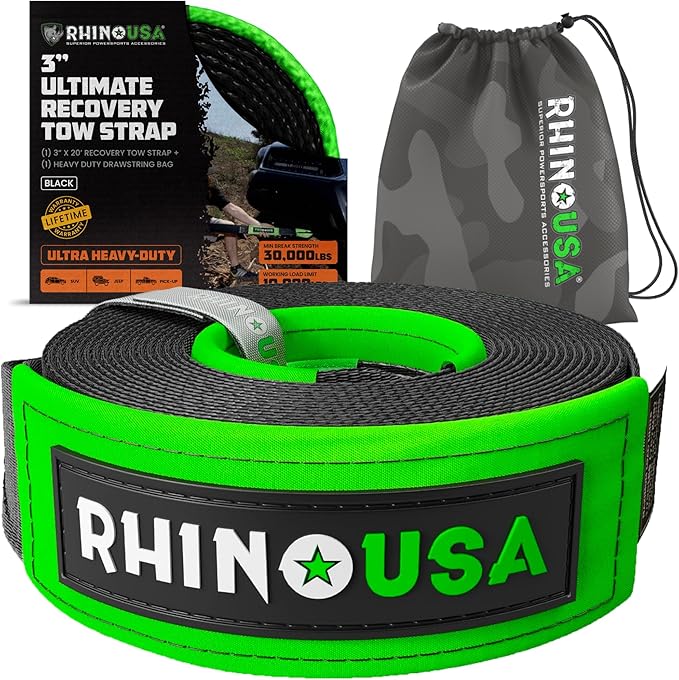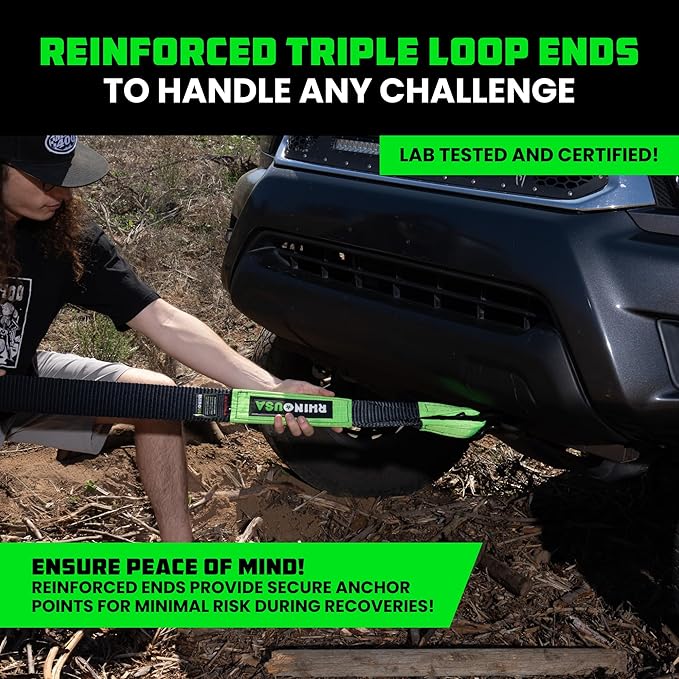Product Review: Rhino USA Recovery Tow Strap
Review: Rhino USA Recovery Tow Strap (3" × 20') — Built Tough for Controlled Recoveries
31,518 lb break strength • Static polyester webbing • Triple-reinforced loop ends • Lifetime replacement
Quick Verdict: If you want a reliable, static recovery strap for controlled pulls and on-trail towing, Rhino USA’s 3" × 20' strap is a workhorse. It’s not a kinetic rope replacement, but for straight, steady recoveries it delivers excellent value, rugged build quality, and a standout lifetime replacement promise. View on Amazon ›
What It Is (and the Key Specs)
- Size & rating: 3" × 20' strap with a 31,518 lb break strength.
- Construction: Polyester static webbing for durability and predictable, low-stretch pulls.
- Ends: Triple-reinforced loop eyes to handle abrasion and load stress at connection points.
- Use case: Designed for towing and flat-surface recoveries (not high-snap “yank” recoveries).
- Warranty: Backed by Rhino USA’s lifetime replacement policy.
Specs per manufacturer listing.
Build Quality & Trail Use
The webbing feels purpose-built for off-road abuse: dense, weather-resistant polyester that resists UV, moisture, and grit, with triple-reinforced loop eyes to reduce wear at the highest-stress points. In practical terms, those beefed-up ends help the strap last longer and keep your connections tight and tidy. The 31,518 lb break rating provides a confidence buffer for most mid-size and full-size 4×4 scenarios when the recovery is set up correctly (rated recovery points, correct angles, proper hardware).
Static Strap vs. Kinetic Rope — Why It Matters
This strap is static (polyester), which means it doesn’t stretch significantly under load. That’s ideal for controlled towing, gentle extractions, and relocating a stuck vehicle on relatively flat ground. If you’re attempting dynamic “snatch” recoveries in mud or deep sand, reach for a kinetic rope (nylon) that stretches to store and release energy. In short: use this Rhino strap for steady, predictable pulls; use a kinetic rope when you need elastic energy to help pop a vehicle free.
Safety & Setup Tips
- Attach only to rated recovery points (factory or properly installed aftermarket points).
- Pair with rated shackles (soft or steel) sized for the strap width and anticipated loads.
- Keep pulls straight and steady; avoid shock loads. Use a spotter and clear the danger zone.
- For winching scenarios, use a tree saver (and a dampener on steel cable).
Who It’s For (and Not For)
Great for: Overlanders who want a durable, predictable strap for towing, repositioning, or assisting
gentle extractions on firm or moderately loose surfaces. Perfect as the “always-carry” strap in any recovery kit.
Not ideal for: Drivers who primarily rely on dynamic “yank” recoveries in deep mud/sand —
they’ll be better served by a nylon kinetic rope with controlled stretch.
Pros & Cons
Pros
- High break strength (31,518 lb) for its class
- Static polyester = predictable, controlled pulls
- Triple-reinforced loop ends improve longevity
- Lifetime replacement adds long-term value
Cons
- Not a kinetic rope — limited stretch by design
- 20' length is versatile, but some recoveries benefit from 30'
Key Specs at a Glance
| Product | Rhino USA Recovery Tow Strap |
| Size | 3" × 20' (7.6 cm × 6.1 m) |
| Material | Polyester (low-stretch / static) |
| Break Strength | 31,518 lb (per manufacturer) |
| Ends | Triple-reinforced loop eyes |
| Primary Use | Controlled pulls, towing, gentle extractions |
| Warranty | Lifetime replacement (Rhino USA) |
Static Strap vs. Kinetic Rope vs. Tree Saver
Picking the right recovery tool matters. Here’s how this Rhino strap compares to other common options:
Static Strap (This Product)
- Stretch: Minimal (<5%)
- Best for: Controlled towing, gentle pulls, repositioning
- Avoid for: High-energy “yank” recoveries
- Why choose: Predictable, steady load transfer
Kinetic Rope
- Stretch: High (≈15–30%)
- Best for: Dynamic recoveries in mud/sand
- Avoid for: Towing on-road; uncontrolled setups
- Why choose: Elastic energy helps “pop” a vehicle free
(Use rated points and safe technique.)
Tree Saver Strap
- Stretch: Minimal
- Best for: Anchoring during winching
- Avoid for: Long-distance towing or yanking
- Why choose: Protects trees & recovery points
5-Step Setup Checklist
- Use rated recovery points on both vehicles.
- Attach the strap with rated shackles (soft or steel).
- Clear the danger zone and brief a spotter.
- Apply steady throttle — avoid shock loads.
- Inspect the strap and loops after recovery; dry and store clean.
FAQ
Is this the same as a kinetic rope?
No — this is a static polyester strap for controlled pulls and towing. Kinetic ropes are nylon and designed to stretch.
Can I use it for winching?
It’s not a winch line. For winching, use a tree saver at the anchor and your winch line to the vehicle.
What size vehicles is it good for?
Mid-size to full-size 4×4 recoveries when used correctly with rated hardware and safe techniques.
Bottom Line
The Rhino USA 3" × 20' Recovery Tow Strap is a dependable, no-nonsense staple for any overland recovery kit. Use it for towing and controlled extractions, pair it with rated shackles and proper anchors, and it’ll quietly put in the work trip after trip. The lifetime replacement policy is the cherry on top — peace of mind you don’t often get at this price.
Affiliate link — we may earn a small commission at no extra cost to you.





Comments